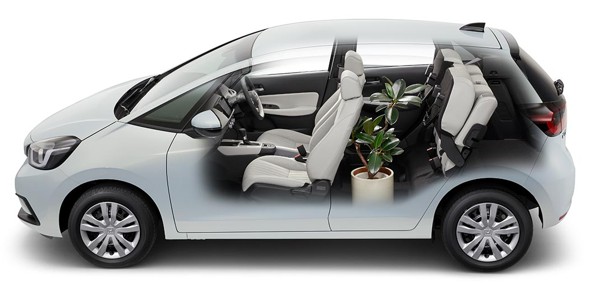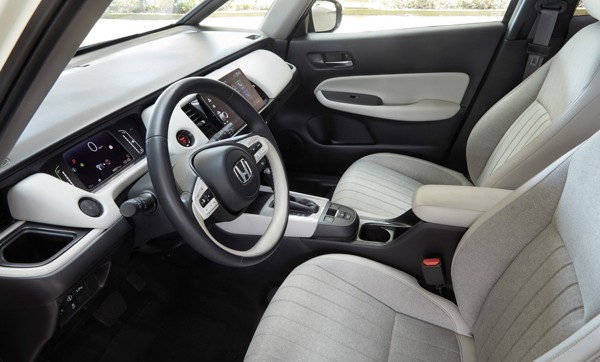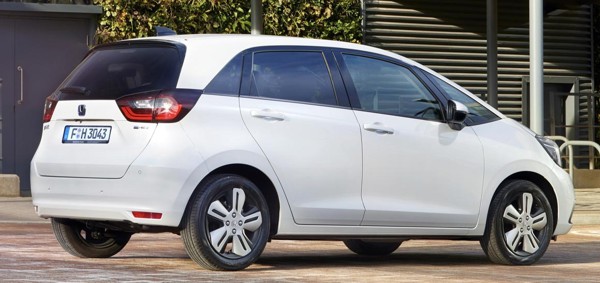Published
on 13
Nov 2020
|
All rights reserved.
|
|

|
|
The
fourth generation Fit sells on fuel economy more than ever...
|
|
Since its birth in 2001,
Honda Fit has been renowned for incredible space efficiency and
practicality. It is smaller than an average B-segment supermini, yet it
provides a spacious accommodation and luggage flexibility that might
shame even some MPVs. This tradition has been carried over to the Mk2
born in 2008 and Mk3 introduced in 2013. Now entering the fourth
generation, can the old dog learn new tricks?
In terms of packaging, frankly, there are hardly any new areas can be
explored, because it is already close to perfect. As before, the new
Fit (or Jazz in Europe) is a compact hatchback measuring only 4 meters
long and 1.7 meter wide. It seeks extra space from the Z-axis – at 1515
mm, it is taller than a Ford Fiesta by 50 mm and Volkswagen Polo by 70
mm. This tallness is not without reasons. As before, it puts the fuel
tank underneath the front seats, so that it can free up the space
beneath the rear seats for luggage carrying. As a result, the driving
position is raised, and the roof has to follow suit.
The central fuel tank layout is still unique in the industry. It
gives the car an unrivalled luggage carrying capability. Want to place
tall items like plants? No problem, lift the rear seat cushions will
reveal a deep luggage space in the cabin. Want a deep and completely
flat load bay? You can drop the rear seat cushions into the footwell,
fold their seatbacks and the latter will align neatly with the boot
floor. Stack up to the roof, you get 1200 liters of luggage space. Fold
the front passenger seat and you can place a small bicycle, much more
convenient and secured than mounting it over the roof. That said, small
EVs with skateboard floorpan are going to break its domination in this
respect.

|
|
The
central fuel tank is still a unique feature, giving it unrivalled
luggage carrying capability.
|
|
Like the Mk3, the new Fit has a monospace shape. Its windscreen is
simply an extension of the bonnet, creating a strong sense of
spaciousness ahead of the driver. While the Mk3 was criticized for its
thick A-pillars hampering front quarter visibility, which could create
serious blindspots when driving out of junction, the new car solves
this problem by splitting each A-pillar into two. The frontmost pillar
is ultra-slim, while structural strength is provided by the thicker
second pillar. In this way, good visibility is provided by the large
front quarter window filling between the two pillars. You might say a
simpler and more conventional solution is to abandon the monospace
shape, moving the base of the windscreen a few inches back. Anyway, if
Honda wants to keep the perception of spaciousness ahead of the driver
– even though that space is hardly usable – this is probably the only
solution.
However, in my eyes the monospace shape is somewhat an outdated
concept. Renault was one of the pioneers of monospace design when
Patrick Le Quement created the original Twingo. Today’s Twingo has
reverted to a conventional shape, even though its rear-engined layout
should have been a perfect match with the monospace concept. People see
monospace as a symbol of MPV, and the latter is thought to be boring,
falling out of market favour. The design team of Honda Fit seems to
react too slowly to the market trend. More problematic, the new car
does not look very stylish. Certainly not as funky as Honda E. Neither
is it as desirable as a Renault Clio or Peugeot 208. Crosstar, the
high-riding pseudo-crossover version of the car, actually looks better.

|
|
Cabin
looks more inviting. Visibility is improved.
|
|
Still, the spacious cabin, the horizontal and uncluttered dashboard as
well as some soft paddings in lighter colours do create an inviting
environment. There are plenty of hard plastics on the dash top and door
panels, but considering its price and functionality you can forgive
that. The small digital instrument and 7 or 9-inch center touchscreen
add to a modern theme, while the infotainment system responds quickly
and takes no learning to use. Compared with the old car, the front
seats here are more supportive yet comfortable. The rear seats are
benefitted with reclining adjustment. Four six-footers can feel at
home, with plenty of head and leg room, something rare in the
B-segment. Moreover, by reshaping the fuel
tank, there is now enough room underneath the front seats for rear
passenger’s feet. In-cabin storage space is aplenty, too.
The new car's engine range is limited to 2 units only. In Japan, the
cheaper engine choice is a
1.3-liter i-VTEC Atkinson-cycle port-injection. It sounds outdated
because it is actually carried over from the last generation without
change – except losing 2 horsepower. It mates with a conventional CVT,
so the focus is on economy rather than fun.
As Honda needs to take care of fleet emission in Europe, European
customers get only the more expensive hybrid powertrain. It consists of
a 1.5-liter i-VTEC Atkinson-cycle port-injection – again carried over
from the last generation but loses 12 horsepower – and a new i-MMD
hybrid system. The Fit is not new to the world of hybrid, of course. As
early as the Mk2, it already had a hybrid model using the company’s IMA
hybrid technology. The Mk3 improved that to i-DCD, which still employed
a single motor for both the work of propulsion and regeneration, but it
used a DCT gearbox cleverly to link between the two power sources,
which is a relatively simple and cost-effective solution. Anyway, after
a decade’s development, Honda finally abandons its original path and
turns to the same solution as Toyota’s Hybrid Synergy Drive. Now it has
2 motors, one dedicated for propulsion and another dedicated to
regeneration, so that each can be specced to do their job more
efficiently. In EV mode, the lithium battery provides all the power at
speed up to 40 mph. When more power is called for, or when the battery
runs low, the engine kicks in, but instead of driving the front
wheels directly, it drives the generation motor, which supply
electricity to the propulsion motor and at the same time recharge the
battery. However, for extended high-speed cruising, there is no reason
to waste power through the generation-propulsion process, so there is a
clutch to lock up the engine and drive the front wheels directly,
bypassing the electric system. The i-MMD also follows Toyota's
approach to use a planetary CVT gearbox to connect the two motors and
engine together, although it programmed the system such that it can
mimic a 7-speed gearbox.
 |
|
After
a decade’s development, Honda finally abandons its original path and
turns to the same solution as Toyota’s Hybrid Synergy Drive...
|
|
The i-MMD system is not only more energy efficient than i-DCD, but its
propulsion motor is also a lot more powerful: 109 hp and 187 lbft
instead of 29.5 hp and 118 lbft. This allows the car to use hybrid or
EV mode more frequently to save fuel further, and in hybrid mode the
performance is stronger. It takes a respectable 8.8 seconds to go from
0-60 mph. Good for a car which achieves WLTP emission of 104 grams per
kilometer. In the real world, its fuel economy is equally remarkable.
Driving leisurely and you will find the hybrid powertrain peaceful and
refined. However, if you are after driving excitement, it is hard to
satisfy you. For sure it feels more powerful than the old Hybrid, as
there is stronger shove at low speed acceleration afforded by the
bigger motor, if not quite in the same league as any pure electric
cars. However, under hard acceleration the engine drones quite noisily
due to the effect of CVT. Now you will moan the lost of the old car’s
132 hp 1.5-liter engine and 6-speed manual gearbox.
Likewise, the handling and ride combination is a mixed bag. Honda has
stiffened its suspension in an attempt to cut body roll. It also fitted
it with a variable-ratio steering, which is rare in the supermini
field. To some extent it is a success, resulting in better body control
on twisty roads and a quicker steering response. However, for keener
drivers the
Fit/Jazz still lacks the body control and steering feedback that made
some European superminis fun to drive, let alone an interactive chassis
balance. The stiffer suspension setup also results in a choppy ride,
especially at lower speeds over broken surfaces. Its dynamics facet is
far
from polished. In addition to the quite boring look, the new car needs
to sell on fuel economy more than ever.
|
Verdict:    |
|